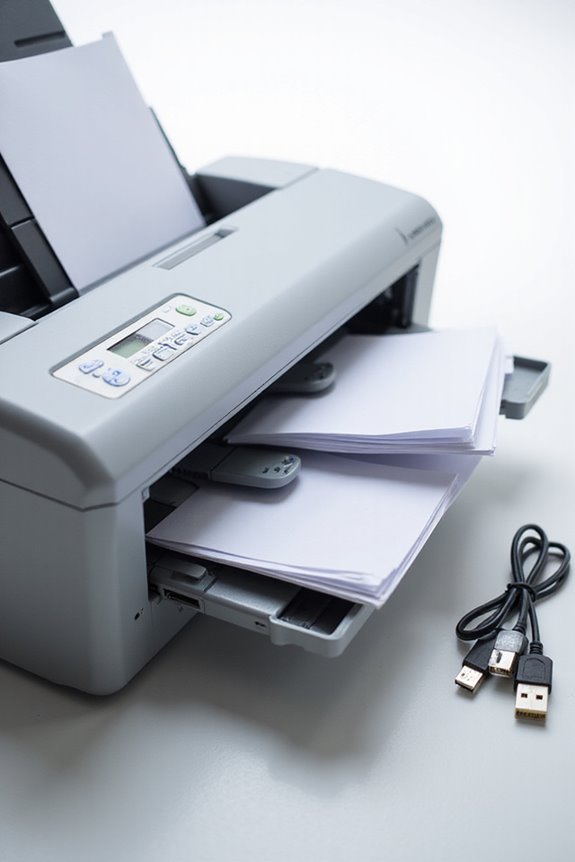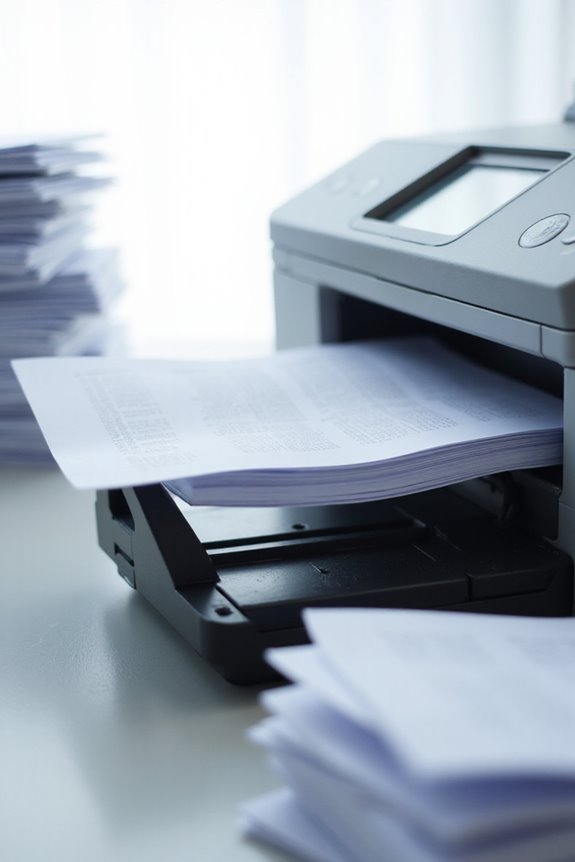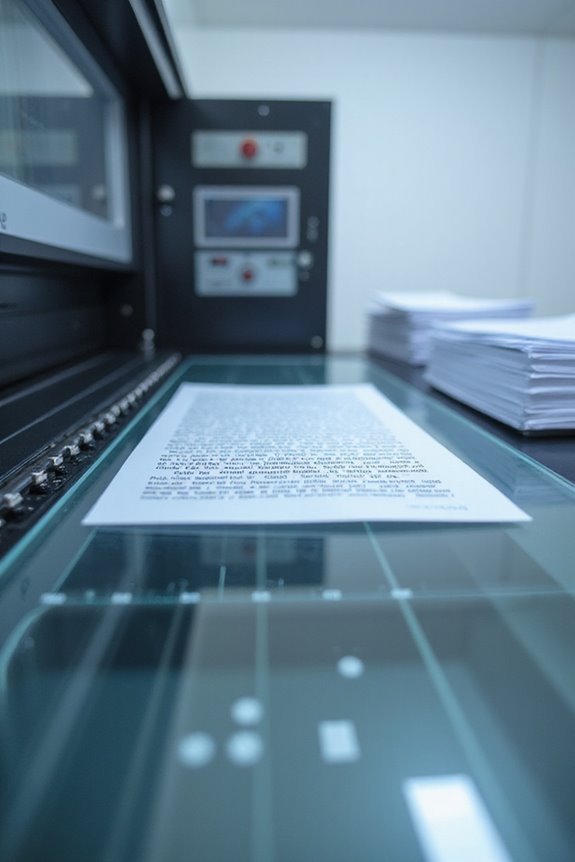To batch scan large volumes of documents efficiently, we should use high-speed scanners with automatic document feeders (ADFs) that accommodate up to 750 sheets. Scanning speeds over 150 pages per minute enhance productivity, while features like double-feed detection reduce errors. It’s essential to prepare documents by removing staples and organizing them into logical batches. Regular checks during scanning guarantee quality, and utilizing software for indexing will make retrieval easier. Let’s explore more best practices.
Key Takeaways
- Organize documents by size and type, removing fasteners and flattening pages to ensure smooth scanning.
- Select a high-volume scanner with an ADF that can handle at least 100 sheets for efficiency.
- Use scanning software with presets to streamline recurring tasks and manage large volumes effectively.
- Set the scanner resolution to a minimum of 300 DPI for optimal readability and OCR accuracy.
- Monitor the scanning process in real-time to catch and correct errors immediately, ensuring quality control.
Understanding Batch Scanning Requirements
When we consider batch scanning requirements, it’s essential to identify the right equipment and settings that truly enhance our efficiency. High-volume production-grade scanners with Automatic Document Feeders (ADFs) holding over 100 sheets can considerably reduce interruptions. Ideally, these scanners should scan rapidly, exceeding one page per second, which helps us tackle batch scanning challenges swiftly. It’s crucial to choose models that support features like double-feed detection and blank page removal to minimize errors. Additionally, by setting appropriate scanning resolutions, we can balance image quality with file size, ensuring optimal performance and storage. Using software presets can streamline recurring tasks, enhancing our overall productivity with batch scanning technologies for seamless digitization. Scanners with high optical resolutions ensure clarity in scanned documents, further improving output quality.
Preparing and Organizing Documents for Scanning

After understanding the requirements for batch scanning, we need to focus on how to prepare and organize our documents effectively. First, we should assess the document condition and eliminate any physical obstacles like staples or clips that can cause jams. Next, we’ll smoothly flatten wrinkled pages and separate stuck sheets to guarantee every page scans clearly. Sorting documents into logical batches by size and type not only helps with organization but also enhances our scanning efficiency. We can label these batches with metadata for easier indexing afterward. Finally, let’s maintain original containers to keep track of items and facilitate easy reference once the scanning process is complete. Proper preparation will save us time and improve the accuracy of our digital records, especially when utilizing high scanning speeds that enhance efficiency during the process.
Selecting the Right Equipment for High-Volume Scanning

Selecting the right equipment for high-volume scanning can greatly enhance our workflow efficiency and document management. High-volume scanners, like the Ricoh fi-8950, can scan up to 150 double-sided pages per minute. Their large ADFs, holding between 50 to 750 sheets, considerably reduce reloads, improving workflow optimization. We should also consider versatile paper paths and multi-feed detection technology to prevent jams. For image quality, an optical resolution of around 400 dpi is ideal for OCR accuracy. Additionally, software integration with features like batch scanning and OCR functionality streamlines our tasks. Remember, durable equipment and regular maintenance keep our scanners performing at their best, ensuring we consistently meet our large batch scanning needs efficiently. Moreover, high-quality models often last longer with regular upkeep, making them a wise investment for ongoing document management success.
Implementing Effective Scanning Workflows

Implementing effective scanning workflows can greatly boost our productivity and accuracy. By defining clear objectives based on document types and volumes, we can streamline the entire process. Workflow optimization is key; mapping each step—from document preparation to indexing—ensures seamless shifts. During document preparation, removing fasteners and aligning pages can reduce jams, enhancing our scanning efficiency. Document categorization further aids in swift processing and later indexing, aligning with our efficiency goals. We should also leverage automation tools, like batch scanning software and OCR, to convert scanned images into searchable formats. Additionally, utilizing high-resolution capabilities ensures clarity and accuracy in scanned images, which is vital for preserving quality in digital collections. Integrating these practices with existing systems not only improves access but also maintains consistency, ultimately supporting our large-scale scanning operations effectively.
Ensuring Quality Control During the Scanning Process

Quality control during the scanning process is crucial to achieving high-quality digital documents. To start, we should guarantee all documents are prepared properly—removing staples or clips and cleaning them to enhance image clarity. We’ll also standardize sizes, making our workflow smoother.
Next, optimizing scanner settings is key; using at least 300 DPI guarantees readability, while higher resolutions are essential for detailed images. We must monitor scans in real-time to catch any issues immediately, performing interim checks for clarity. Additionally, understanding the importance of compatibility with various document types can further enhance scanning efficiency.
Finally, implementing a digital quality assurance log helps us track errors and measure improvements over time. By establishing these steps, we not only maintain uniformity and accuracy but also enhance our overall scanning efficiency.
Indexing and Storing Scanned Documents
While we may have put in the work to scan documents, efficiently indexing and storing them is just as critical to confirm we can access and retrieve information quickly. By employing smart indexing strategies, we can create a clear, standardized system that mirrors our physical filing methods. Utilizing Optical Character Recognition (OCR) technology enhances searchability, transforming scanned images into easily indexable text. For storage solutions, using secure, scalable options like cloud or network-attached storage confirms we can access documents from anywhere while keeping them safe. Regularly updating our indexes and employing metadata management techniques helps maintain organization and accuracy, making it simpler for us to find the right documents in a fraction of the time. Additionally, integrating with popular cloud services can streamline document management and enhance accessibility across devices.
Managing Project Delivery and Data Security
Effective management of project delivery and data security goes hand in hand with the accurate scanning and indexing of documents. First, we need to define the project scope, clearly detailing the volume and type of documents. Establishing robust communication protocols between our team and stakeholders guarantees that everyone is informed throughout the process. We must also set a detailed timeline, allocating resources such as manpower and equipment effectively. Additionally, recognizing any special handling requirements for sensitive documents early on is vital for maintaining data security. Finally, implementing role-based access and encryption for scanned files will protect our data, while continuous monitoring keeps us compliant with data protection regulations. By doing this, we safeguard both project integrity and sensitive information.
Frequently Asked Questions
What Types of Documents Are Suitable for Batch Scanning?
As the saying goes, “A stitch in time saves nine.” We’ll find legal documents, financial records, marketing materials, and historical archives are all perfect candidates for efficient batch scanning. Let’s embrace this streamlined approach together!
How Can I Minimize Document Preparation Time Before Scanning?
To minimize document preparation time, we should focus on effective document organization. By sorting documents and removing fasteners, we can greatly enhance scanning efficiency, ensuring a smoother and quicker scanning process for everyone involved.
What Is the Average Turnaround Time for Batch Scanning Projects?
When considering turnaround time for batch scanning projects, we’ve found that project timelines depend on various factors, including volume, resource allocation, and whether additional services like OCR are included. Let’s optimize our approach together.
Can I Scan Color Documents, or Is Black and White Preferred?
We can scan color documents for their unique benefits, like retaining important details, but we often prefer black and white for its advantages in clarity, smaller file sizes, and faster processing—ideal for text-heavy content.
What File Formats Are Best for Storing Scanned Documents?
When considering the best file formats for storing scanned documents, we recommend PDF for its versatility and accessibility. For high-quality needs, TIFF’s benefits are unmatched, preserving original details essential for archiving and professional use.





